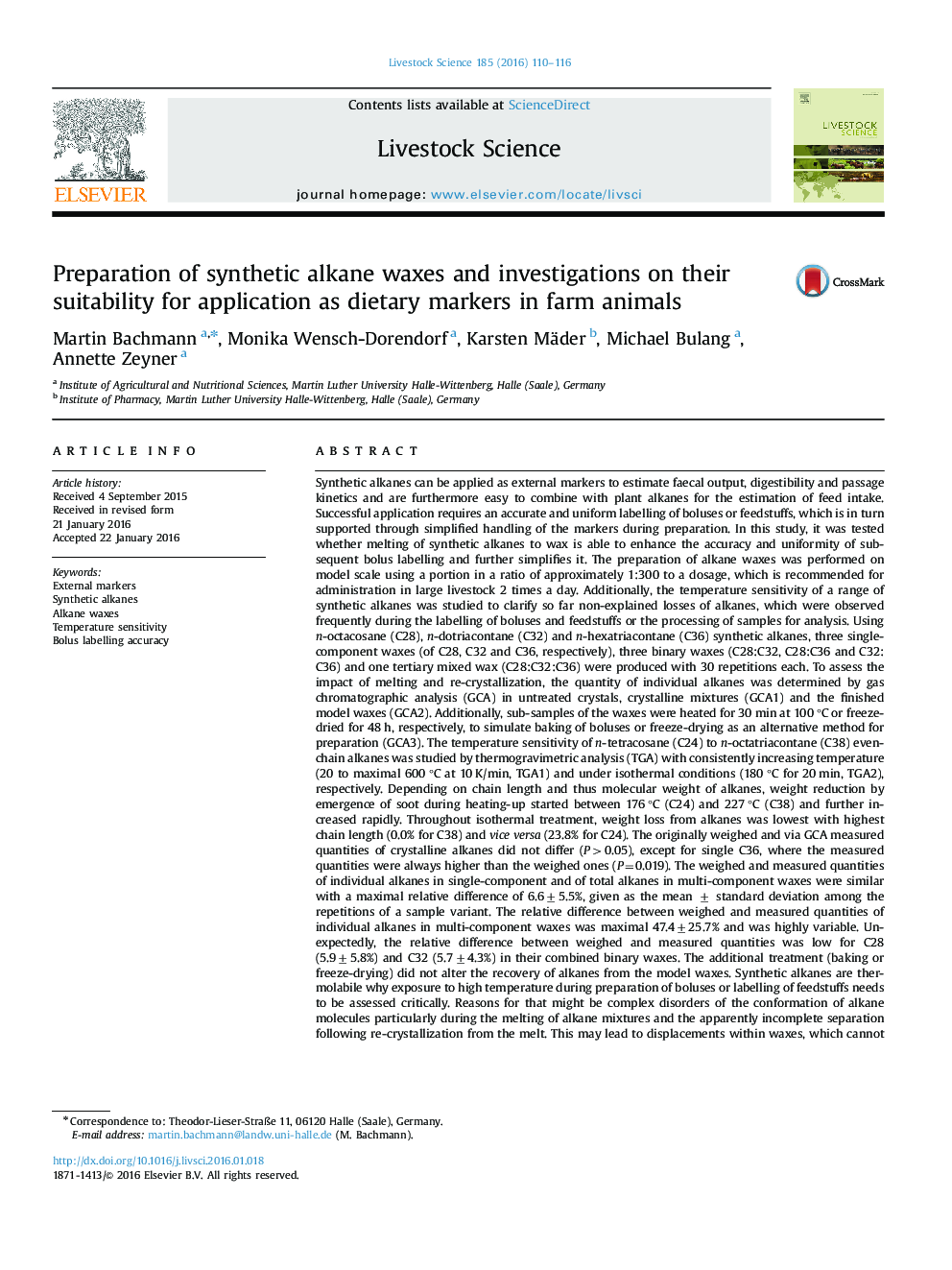| کد مقاله | کد نشریه | سال انتشار | مقاله انگلیسی | نسخه تمام متن |
|---|---|---|---|---|
| 2446935 | 1553947 | 2016 | 7 صفحه PDF | دانلود رایگان |
• Synthetic alkanes are thermolabile.
• Mass losses occurred depending on chain length, temperature and time of exposure.
• Preparation of alkane waxes simplified the labelling of boluses.
• Suitability for application as markers is limited, particularly in mixed waxes.
• Displacements of alkanes were detected in mixed waxes that cannot be foreseen.
Synthetic alkanes can be applied as external markers to estimate faecal output, digestibility and passage kinetics and are furthermore easy to combine with plant alkanes for the estimation of feed intake. Successful application requires an accurate and uniform labelling of boluses or feedstuffs, which is in turn supported through simplified handling of the markers during preparation. In this study, it was tested whether melting of synthetic alkanes to wax is able to enhance the accuracy and uniformity of subsequent bolus labelling and further simplifies it. The preparation of alkane waxes was performed on model scale using a portion in a ratio of approximately 1:300 to a dosage, which is recommended for administration in large livestock 2 times a day. Additionally, the temperature sensitivity of a range of synthetic alkanes was studied to clarify so far non-explained losses of alkanes, which were observed frequently during the labelling of boluses and feedstuffs or the processing of samples for analysis. Using n-octacosane (C28), n-dotriacontane (C32) and n-hexatriacontane (C36) synthetic alkanes, three single-component waxes (of C28, C32 and C36, respectively), three binary waxes (C28:C32, C28:C36 and C32:C36) and one tertiary mixed wax (C28:C32:C36) were produced with 30 repetitions each. To assess the impact of melting and re-crystallization, the quantity of individual alkanes was determined by gas chromatographic analysis (GCA) in untreated crystals, crystalline mixtures (GCA1) and the finished model waxes (GCA2). Additionally, sub-samples of the waxes were heated for 30 min at 100 °C or freeze-dried for 48 h, respectively, to simulate baking of boluses or freeze-drying as an alternative method for preparation (GCA3). The temperature sensitivity of n-tetracosane (C24) to n-octatriacontane (C38) even-chain alkanes was studied by thermogravimetric analysis (TGA) with consistently increasing temperature (20 to maximal 600 °C at 10 K/min, TGA1) and under isothermal conditions (180 °C for 20 min, TGA2), respectively. Depending on chain length and thus molecular weight of alkanes, weight reduction by emergence of soot during heating-up started between 176 °C (C24) and 227 °C (C38) and further increased rapidly. Throughout isothermal treatment, weight loss from alkanes was lowest with highest chain length (0.0% for C38) and vice versa (23.8% for C24). The originally weighed and via GCA measured quantities of crystalline alkanes did not differ (P>0.05), except for single C36, where the measured quantities were always higher than the weighed ones (P=0.019). The weighed and measured quantities of individual alkanes in single-component and of total alkanes in multi-component waxes were similar with a maximal relative difference of 6.6±5.5%, given as the mean ± standard deviation among the repetitions of a sample variant. The relative difference between weighed and measured quantities of individual alkanes in multi-component waxes was maximal 47.4±25.7% and was highly variable. Unexpectedly, the relative difference between weighed and measured quantities was low for C28 (5.9±5.8%) and C32 (5.7±4.3%) in their combined binary waxes. The additional treatment (baking or freeze-drying) did not alter the recovery of alkanes from the model waxes. Synthetic alkanes are thermolabile why exposure to high temperature during preparation of boluses or labelling of feedstuffs needs to be assessed critically. Reasons for that might be complex disorders of the conformation of alkane molecules particularly during the melting of alkane mixtures and the apparently incomplete separation following re-crystallization from the melt. This may lead to displacements within waxes, which cannot be foreseen or quantified, and thus to the loss of their suitability as dietary markers. Alkane recovery from binary waxes of C28 and C32 was unbiased on model scale and whether this can be confirmed on original scale needs to be validated further. For practical use, alkane waxes might nevertheless be beneficial because the handling is easier than that of alkane crystals.
Journal: Livestock Science - Volume 185, March 2016, Pages 110–116
